This content originally appeared on Bits and Pieces - Medium and was authored by Minura Samaranayake
GraphQL vs Odata API
What is the best standard for modern APIs?
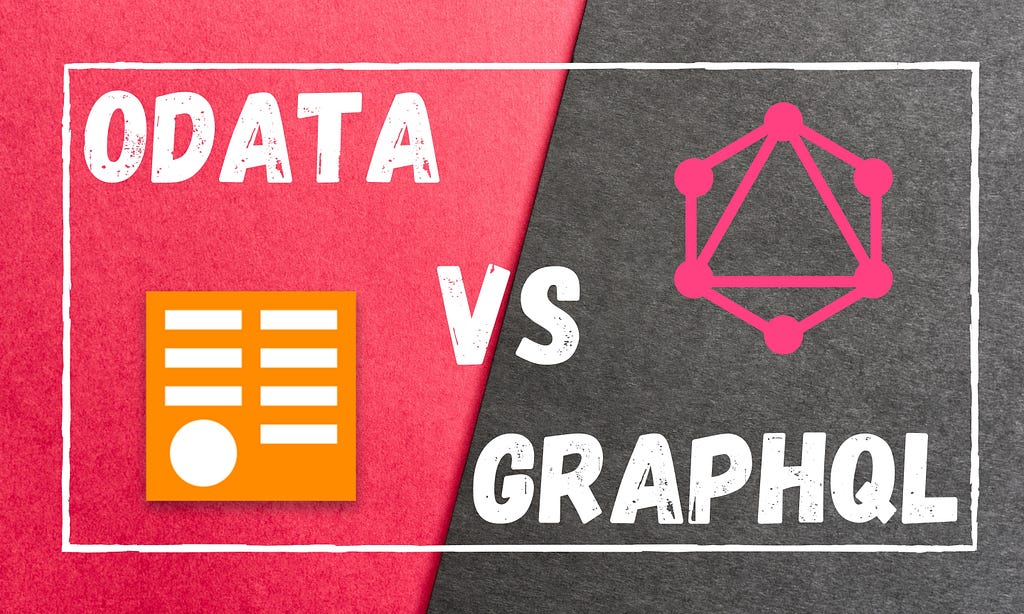
OData and GraphQL are widely used as standards for API development. At a glance, they appear to be very similar and serve the same purpose. However, choosing one is not easy since they both have some unique features.
In this article, I will compare and contrast OData and GraphQL to see the best option for APIs.
GraphQL — Smart Query Language for APIs
GraphQL is a query language and a runtime used to query and update data for APIs.
GraphQL gives freedom for users to demand exactly what they want. It makes it simpler to update APIs with time. Furthermore, it supports sophisticated developer tools by providing a clear and comprehensive explanation of the data in your API.
Note: The Schema language used by GraphQL isn’t dependent on any particular database management system and can be used with your existing data and coding.
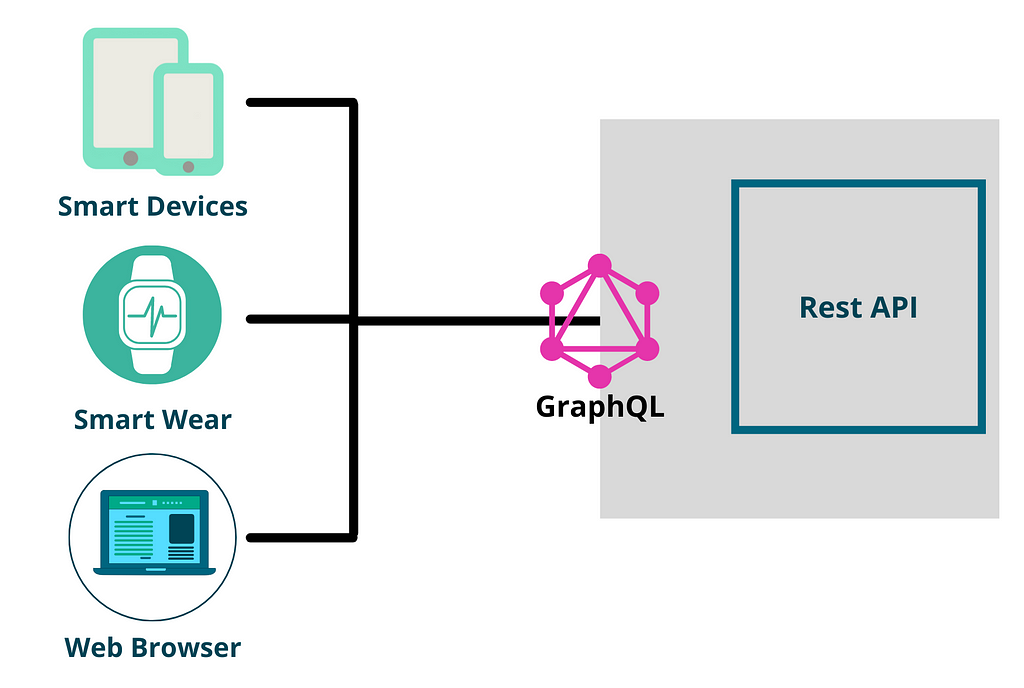
GraphQL needs to have a single URI mapped to a web service with an API for complete data acquisition and alteration. As a result, a user can request a dataset from a server by sending a query string that specifies what they require. So, it is capable of handling even the most advanced data requirements.
It is not RESTful, but it offers a variety of libraries for querying and updating data.
Also, it handles everything in a query via a single request/response cycle, including joins, selects, versioning, relationships etc.
Finally, as a widely accepted standard, it’s strong in providing end-users with self-documenting APIs that allow them to develop production-ready applications utilizing data from any source.
When to Use GraphQL?
GraphQL will come in handy:
- In applications for devices with bandwidth consideration, such as IoT devices, mobile phones, smartwatches, where you need attribute filtering.
- In applications that require a single request to get nested data to reduce the impact from latency. For example, a person comments on a post on social media, and we need to fetch the post along with the nested comments and details of the person who commented.
- For APIs that require to provide flexible query patterns to tailor wide range of use cases and integrations.
- When the API consumes multiple and APIs and database storage internally and return a common interface.
- GraphQL can abstract an existing API for client-side proxy patterns, allowing each end-user to provide their expected response structure.
Advantages of Using GraphQL:
- Faster as it reduces the size of your request query by selecting only the fields you want to query.
- Complex systems and microservices are well-suited with GraphQL.
- Single API call for fetching nested data.
- No over-fetching and under-fetching problems.
- Detailed error messages.
- Code-sharing is possible (reuse code).
Disadvantages of Using GraphQL:
- High learning curve.
- Queries could be complex.
- Complicated in implementing a caching system.
- File uploads aren’t allowed, so you have to use a separate API for file handling.
OData — Standardizing REST
OData, aka Open Data Protocol, is a standard that describes the best practices for constructing and consuming REST APIs for the user.
OData uses web technologies like HTTP and JSON to give users access to data from different sources. It provides an easy and consistent method for conveniently sharing data across data sources, applications, services and clients. Also, OData can be used for integration across products with the HTTP protocol stack.
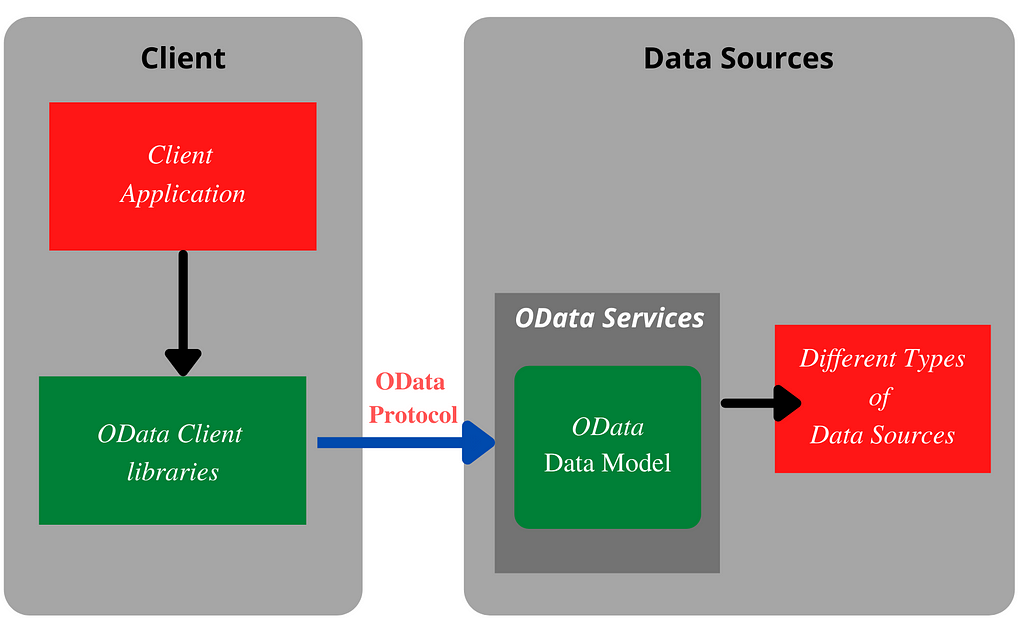
Note: The most essential OData component protocol is REST. Unless there is a solid and particular reason not to use it, OData users should strictly follow REST principles.
OData provides instructions on how to track changes, define reusable methods, and send multiple REST requests.
When to Use OData?
OData will come in handy:
- When your API consumers are a diverse set of developers using a variety of tools and, you don’t want to spend much time learning and coding against different APIs, it is good to go for OData.
- OData is suitable to use when performance is more prominent.
- Typically better when you need to grant access to your database for CRUD operations with minimal effort.
- When you want to consume multiple data sources.
- When working on complex applications, you have to focus more on business logic rather than worrying about how to configure request and response headers, status codes, HTTP methods etc. In such situations, OData would be a good option.
Advantages of Using OData API:
- Supports HTTP, Atom Pub, and JSON.
- Retrieval of data can be done based on the URL.
- Any form of the data source is supported. A custom class can also be used as a data source.
- There is no requirement to establish a proxy service object. As a result, it is easy to use.
- Provides full support for CRUD.
- Since OData is lightweight, server-client interaction is fast; therefore, performance is better.
Disadvantages of Using OData API:
- Fine-grained access control is difficult as we have to enforce it at different levels.
- OData contract does not provide sufficient information for consumers on how to use the services.
- Before using the API, users should be familiar with the schema in detail.
Why do we Need GraphQL or OData when we have REST?
REST is more concerned with API durability than query optimization.
GraphQL, on the other hand, is designed to operate over a single endpoint over HTTP, hence improving performance and adaptability. Meanwhile, OData defines best practices for developing REST APIs that work on top of the REST architecture.
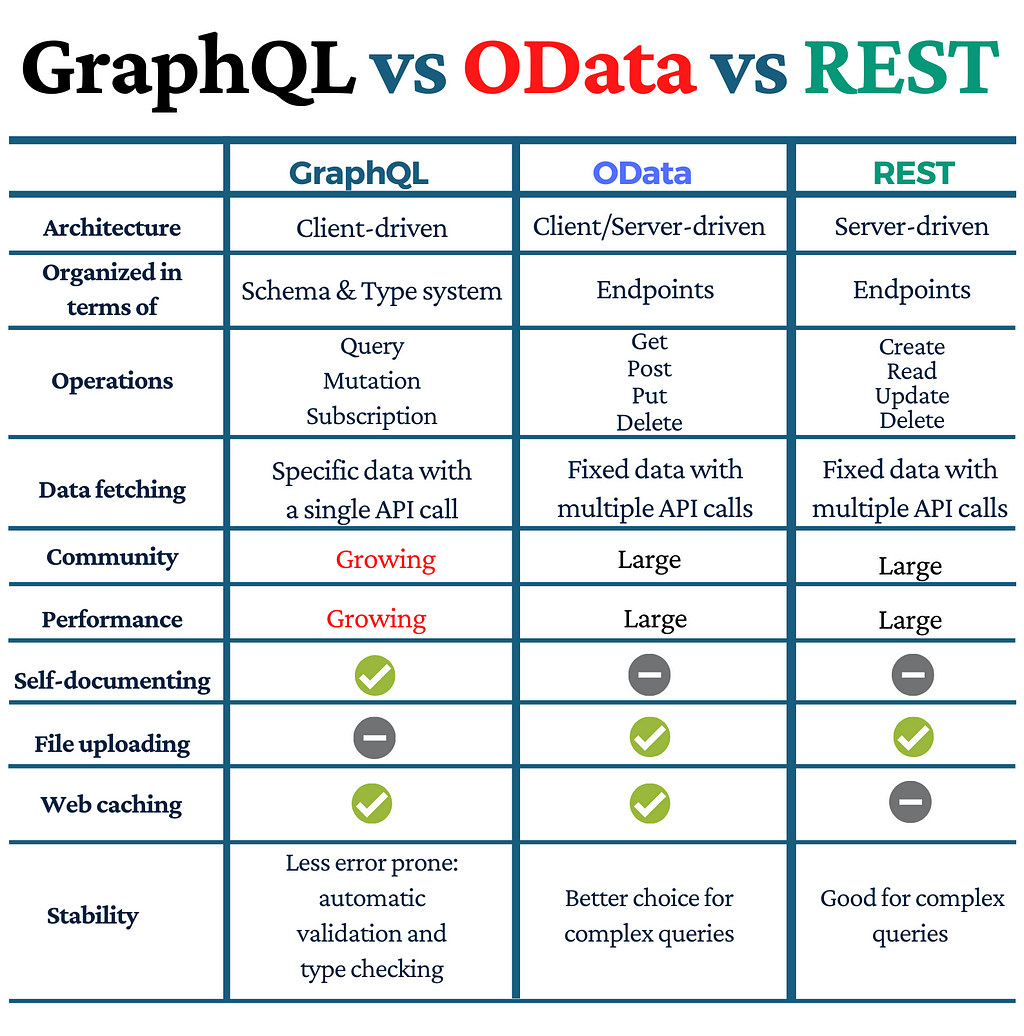
OData vs GraphQL - Comparison
At the cost of a high coupling, OData can bring the power of SQL to the URI with library and framework support. It works best for REST APIs, that need more of a standard set of schema. Although creating a single OData schema for your entire organization is technically possible, it would be difficult to construct and maintain.
GraphQL, on the other hand, makes it simple to establish a single data graph for your entire organization. It also brings in many benefits with its wide adoption.
To make it more valuable, the following table shows a head-to-head comparison between GraphQL and OData.
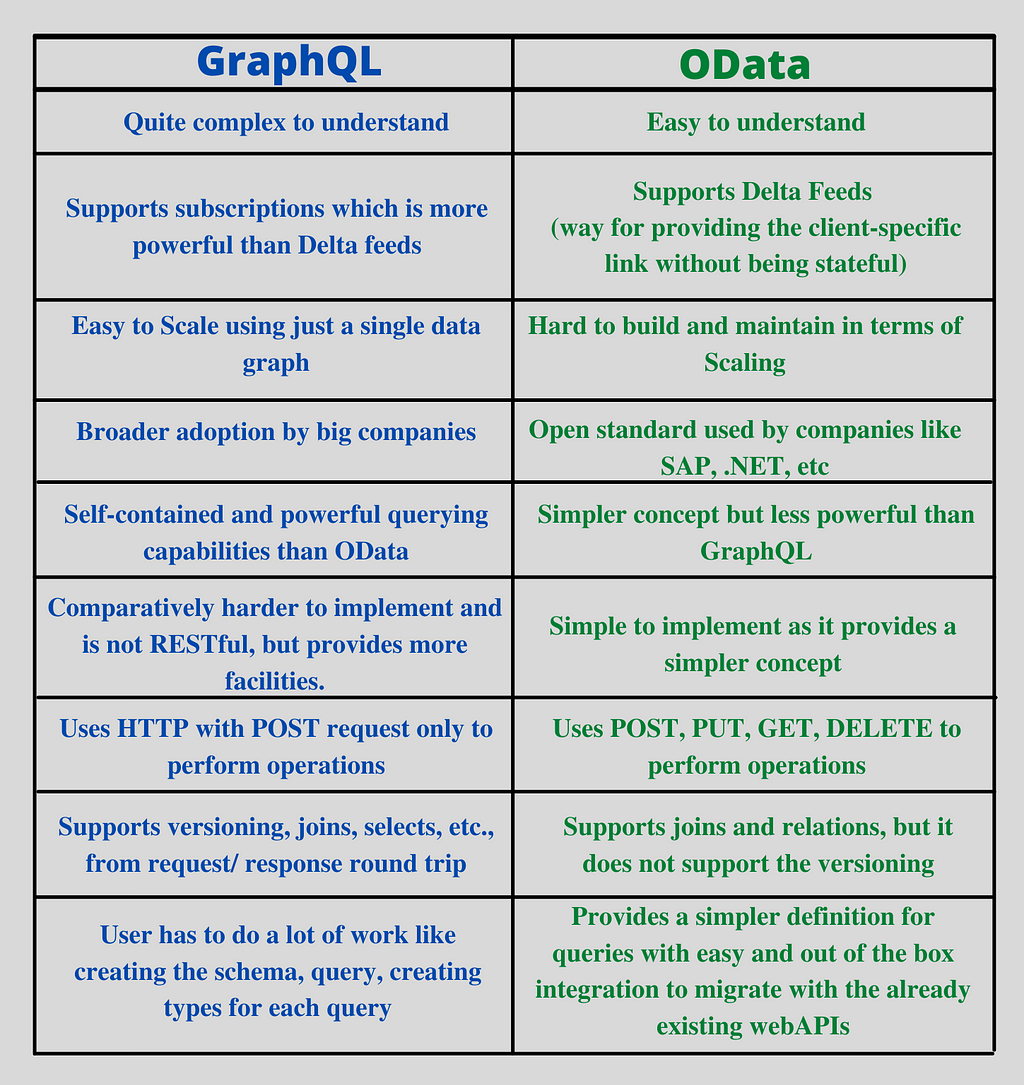
Conclusion
In this article, I evaluated two API standards, GraphQL and OData API.
This comparison demonstrates that GraphQL has a steeper learning curve since it isn’t RESTful, like OData. However, it’s pretty subjective to where you are coming from. If you are very much familiar with REST, there are a few concepts you should unlearn. But, for developers who started with GraphQL, it could be a no-brainer.
As you can see, it’s entirely dependent on the developer’s choice and the project requirements. You should consider the nature of integrations, flexibility of the API and consumers before selecting one over the other.
Thank you for Reading!!!
Build Better Component Libs and Design Systems
Share components across teams and projects to speed up development and make sure your users experience a consistent design at every touchpoint.
Bit offers a great dev experience for building, sharing, and adopting components across teams and applications. Create a component hub for free give it a try →
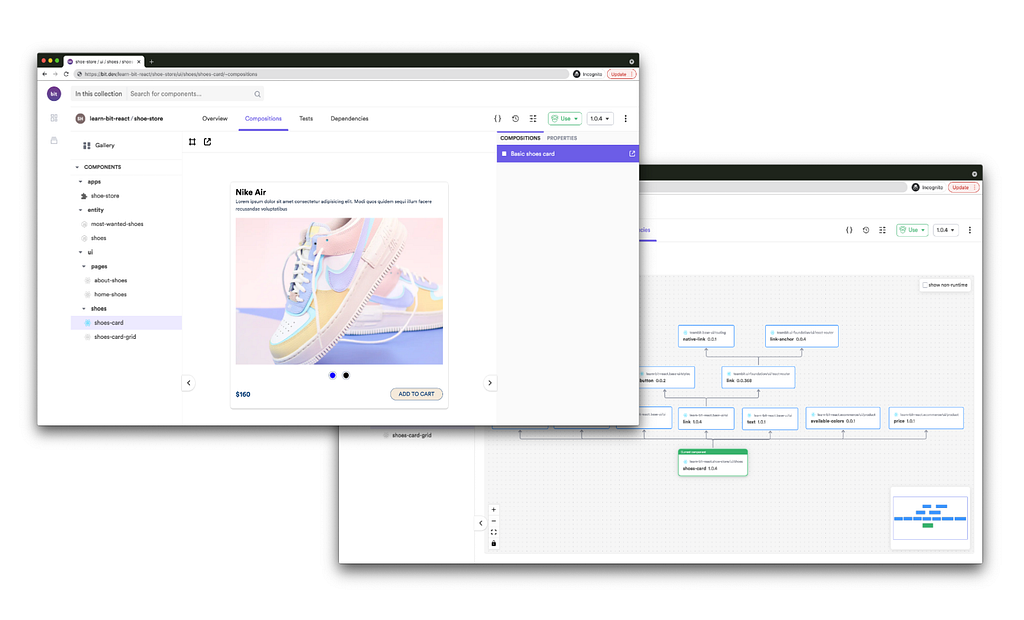
Learn More
- 6 Top GraphQL Clients for 2020
- Make your GraphQL API Easier To Adopt Through Components
- GraphQL — What, Why and How
Choosing between GraphQL vs Odata API was originally published in Bits and Pieces on Medium, where people are continuing the conversation by highlighting and responding to this story.
This content originally appeared on Bits and Pieces - Medium and was authored by Minura Samaranayake
Minura Samaranayake | Sciencx (2021-11-09T01:58:33+00:00) Choosing between GraphQL vs Odata API. Retrieved from https://www.scien.cx/2021/11/09/choosing-between-graphql-vs-odata-api/
Please log in to upload a file.
There are no updates yet.
Click the Upload button above to add an update.
